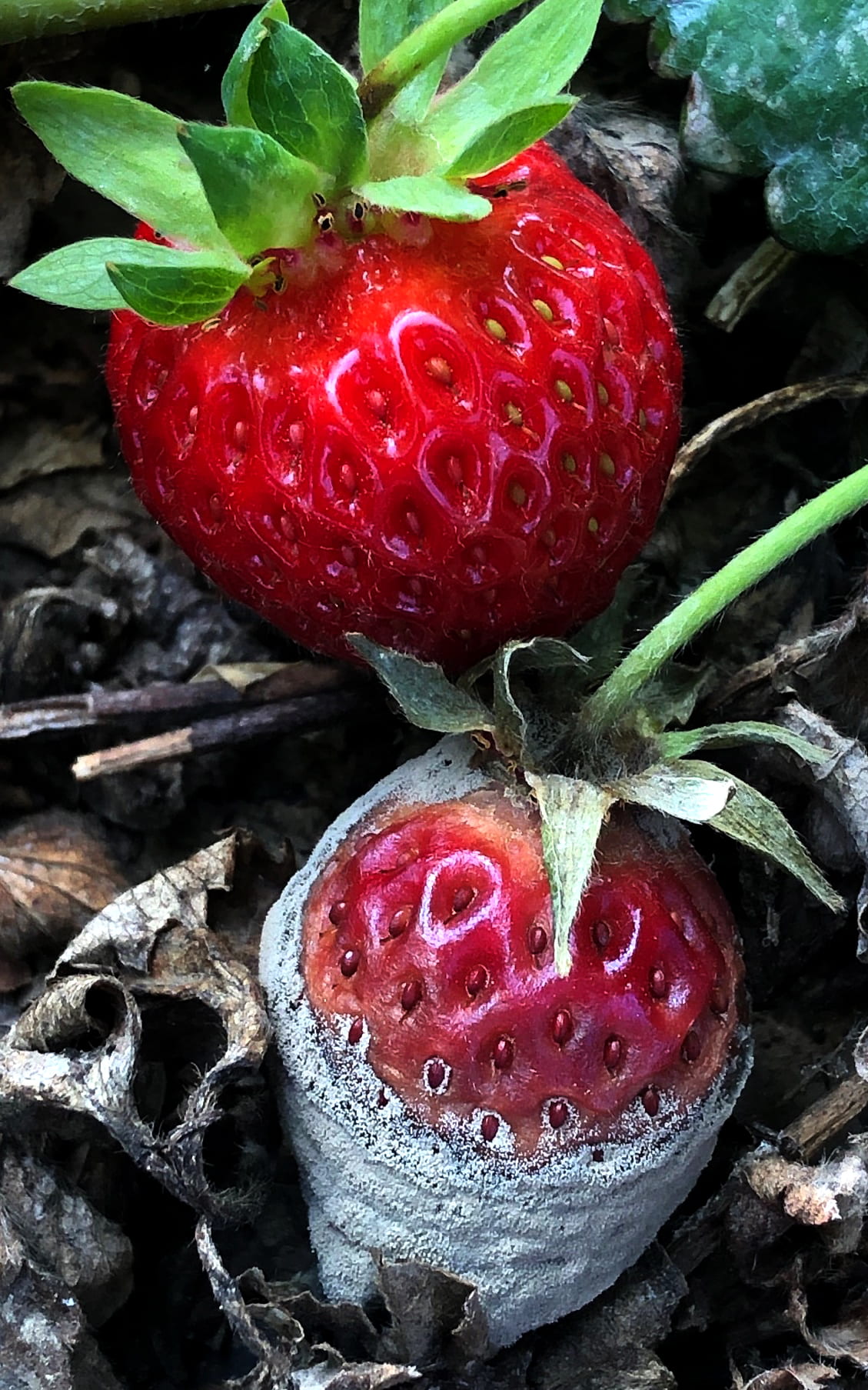Photographs below were taken by Sandra Menasha, Vegetable/Potato Specialist with Cornell Cooperative Extension-Suffolk County.
Gray mold is a common disease in strawberries on Long Island, and often the most important. The fungus causing this disease (Botrytis cinerea) can survive winter in plant debris, has a wide host range, and produces many spores dispersed by wind and splashing water; it is considered the most ubiquitous pathogen worldwide. Diseased tissue from the previous season is an important source of inoculum, therefore gray mold is especially problematic in strawberry crops near fields where the disease occurred the previous year.
In addition to fruit, Botrytis cinerea infects leaves, crown, petals, flower stalks, and fruit caps. This pathogen usually infects dead plant tissue (in particular flower petals) first, then progresses to adjacent healthy tissue. Affected tissue turns brown, then under high humidity the pathogen produces its characteristic, diagnostic gray fuzzy growth that includes many spores. This growth has a velvety appearance on fruit. Infected immature fruit do not develop symptoms because the pathogen remains quiescent (latent) until the fruit begin to ripen; they may be misshaped and may die before maturing. Mature fruit can become infected when in direct contact with rotten fruit, particularly during wet weather. Symptoms can develop after harvest.
While diseased fruit are the major concern, protecting blossoms from infection is the focus for managing gray mold because this is the main way that fruit become infected. Flowers can be infected as soon as they have opened, but their susceptibility increases afterwards and is much greater two to three days after opening. Infection can occur with as little as 6 hours of wetness when it is 40-85 F. Temperatures of 59-77 are most favorable.
Gray mold can be managed with two well-timed fungicide applications during flowering. The first application is recommended at early bloom (5-10%) followed by another 10 days later or at full bloom. Many products are labeled for use on strawberry. Elevate 50WG, CaptEvate 68WDG and Switch 62.5WG are the most effective fungicides for disease management during bloom. Alternate between different fungicide chemistry to manage fungicide resistance. Elevate and CaptEvate share an active ingredient (fenhexamid). It is important to provide fungicide protection throughout bloom, therefore a third fungicide application can be warranted during prolonged bloom periods. An application to protect fruit may be warranted when a prolonged period of humid or wet conditions is forecast before harvest. CaptEvate has some efficacy against anthracnose because it also contains captan. Fungicides for gray mold are not effective for red stele or leather rot. Where these diseases are also a concern consider also applying Aliette 80WDG. Captan, Iprodione, Pristine, Scala, and Topsin-M are also labeled for gray mold. Topsin-M is also labeled for Phomopsis leaf blight and leaf scorch. Captan and Pristine are also labeled for leaf spot and anthracnose. Switch is also labeled for anthracnose.
Fungicides approved for organic production and labeled for gray mold include Actinovate, BacStop, Companion, DoubleNickel, JMS Stylet oil, MilStop, Oxidate, Regalia, Serenade ASO, Serifel, Sporatec AG, Stargus, Timorex Act, Trilogy, and copper.
Control of gray mold can be improved with cultural practices. Length of time leaves and fruit are wet can be minimized by promoting good air circulation, which includes controlling weeds, and overhead irrigating during the day when plants can dry before night. While there are no resistant varieties, ‘Earliglow’, ‘Jewel’ and ‘Clancy’ are the least susceptible. Gray mold tends to be more problematic in crops fertilized with nitrogen in spring.
Please Note: The specific directions on pesticide labels must be adhered to — they supersede these recommendations if there is a conflict. Any reference to commercial products, trade or brand names is for information only; no endorsement is intended. For up-to-date information on labeled fungicides see Cornell Pest Management Guidelines for Berry Crops.
Updated January 2022.





